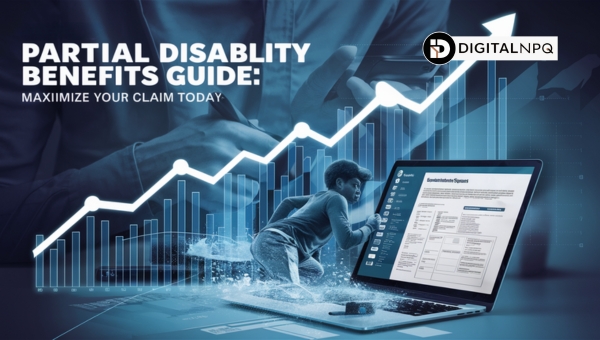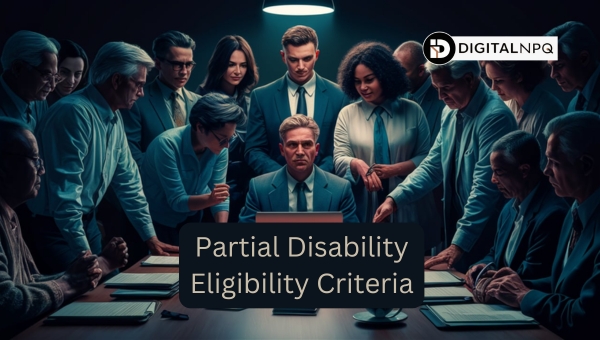Partial Disability Benefits Guide: Maximize Your Claim Today

The world of partial disability compensation can be confusing to navigate. Thank goodness, we are here to make it easier for you. You will discover all the information you require about partial disability benefits in this article, from their definition to the application procedure.
We’ll delve into eligibility criteria, types of benefits, and how compensation is calculated. So, if you’re eager to unlock financial support while adapting to new work capabilities, keep reading!
Understanding Partial Disability Benefits
Partial disability benefits are financial aid provided to individuals who have suffered an injury or illness that hinders their ability to fully perform their job duties but does not completely incapacitate them.

These benefits serve as a safety net, helping to replace a portion of the lost income while the individual recovers or adapts to their new limitations.
- Purpose: The primary goal is to help workers maintain financial stability during their recovery period.
- Coverage: These benefits can be obtained through workers’ compensation programs or private disability insurance policies.
- Duration: The length of time these benefits are provided can vary based on the nature of the disability—whether it is temporary or permanent.
Key Points to Remember:
- Eligibility: To be eligible, the individual must have a documented medical condition that partially limits their work capacity.
- Work Capability: The person must still be capable of performing some tasks, albeit in a reduced capacity or different role.
- Income Replacement: Benefits typically cover a percentage of the worker’s pre-disability earnings.
Partial disability benefits are crucial for those who, despite their limitations, are still able to contribute to the workforce. These benefits ensure that workers can continue to support themselves and their families while they navigate their recovery journey.
Eligibility Criteria
Determining eligibility for partial disability benefits involves several factors. To understand if you qualify, it’s essential to know the basic requirements and consider any special circumstances that might apply.

How to Qualify?
To qualify for partial disability benefits, you generally need to meet specific conditions. These include:
- Medical Documentation: You must have a documented medical condition that partially impairs your ability to work.
- Work-Related: For workers’ compensation claims, the disability must be work-related.
- Reduced Capacity: You should be able to perform some form of work, even if it’s in a different role or at a reduced capacity.
Special Situations
There are unique circumstances that might affect your eligibility for partial disability benefits:
- Pre-Existing Conditions: If a pre-existing condition is worsened by a work-related injury, you might still be eligible.
- Disability Duration: Short-term versus long-term disabilities can impact the type and amount of benefits.
- Age Factors: Older workers may have different criteria or benefit amounts based on their age and proximity to retirement.
Types of Partial Disability Benefits
Partial disability benefits come in different forms, depending on the nature and duration of the disability. Here we will explore temporary partial disability, and permanent partial disability, and how these compare with total disability benefits.

Temporary Partial Disability
Temporary partial disability benefits are designed to assist workers who can return to work in some capacity but not to their full pre-injury level. These benefits are meant to bridge the financial gap while the worker is still recovering.
- Definition: Temporary partial disability refers to a condition where the worker is not completely disabled but can only perform limited or modified duties due to a temporary medical condition.
- Duration: These benefits are typically paid until the worker fully recovers or reaches what is known as maximum medical improvement. This is the point at which the worker’s condition is not expected to improve significantly with further medical treatment.
- Application: To qualify, the worker must provide medical documentation that outlines their limitations and the expected duration of their disability. The employer may also need to offer a modified job role that aligns with these limitations.
- Compensation: The amount received is usually a percentage of the difference between the worker’s pre-injury wages and their current earnings in the modified role. This ensures that the worker can maintain a reasonable standard of living while recovering.
Permanent Partial Disability
Permanent partial disability benefits are for workers who suffer a lasting impairment but can still perform some work. These benefits help individuals adapt to their new, permanent limitations.
- Definition: Permanent partial disability indicates that the worker has a long-term or permanent impairment that reduces their ability to work but does not entirely prevent them from working.
- Duration: These benefits are often paid for a specified period or as a lump sum, depending on the severity and nature of the disability.
- Application: To qualify, the worker must undergo a medical evaluation to determine the extent of the permanent impairment. This evaluation helps in assessing the worker’s new capabilities and limitations.
- Compensation: The amount is generally calculated based on the severity of the impairment and its impact on the worker’s ability to earn. This could be a set amount for specific injuries or a percentage of the worker’s average weekly wage.
Comparisons with Total Disability Benefits
Understanding the differences between partial and total disability benefits is crucial for workers navigating their options.
- Degree of Impairment:
- Partial Disability: Allows for some level of work capability, either temporarily or permanently.
- Total Disability: Indicates that the worker is completely unable to perform any work due to their condition.
- Compensation Amount:
- Partial Disability: Benefits are generally a percentage of the difference between pre-injury and post-injury earnings or based on a predefined schedule.
- Total Disability: Typically offers higher compensation as it covers situations where the worker cannot earn an income at all.
- Duration:
- Partial Disability: Temporary benefits last until full recovery or maximum medical improvement; permanent benefits are for a set period or as a lump sum.
- Total Disability: Benefits continue as long as the worker remains fully disabled, often until retirement age or for life.
By understanding these different types of benefits, workers can better navigate their options and secure the financial support they need during their recovery or adaptation period.
Also Read: VA Disability Pay Dates & New Rates Revealed
Application Process For Partial Disability Benefits
Applying for partial disability benefits may seem challenging, but understanding the process can make it much simpler. Knowing what documents you need and the steps involved will help you navigate the system more efficiently. Let’s break it down into two main parts: documentation and the application steps.
Documentation Required
When applying for partial disability benefits, having the right documentation is crucial. Here’s what you will need:
- Medical records: Detailed reports from your healthcare provider about the nature and extent of your disability.
- Proof of employment: Documents like pay stubs or employment contracts that show your job status and earnings before the disability.
- Work restrictions: Statements from your doctor indicating any limitations or restrictions on your ability to work.
- Post-disability wages: Any evidence showing your current income if you are working in a reduced capacity or different role.
Steps to Apply
Once you have gathered all the necessary documents, you can follow these steps to apply for partial disability benefits:
- Report your injury or illness: Notify your employer as soon as possible about your condition.
- Seek medical treatment: Follow the recommended treatment plan from your healthcare provider.
- Submit documentation: Provide all required documents to the relevant agency or insurance company.
- Complete application forms: Fill out all necessary forms accurately and thoroughly.
- Cooperate with evaluations: Be prepared for any additional assessments or evaluations requested by the agency.
- Follow up: Keep track of your application status and be ready to provide any additional information if needed.
- Appeal if necessary: If your application is denied, you have the right to appeal the decision and provide further evidence.
By following these steps and ensuring you have all the required documentation, you can make the application process for partial disability benefits more manageable.
Assessing Losses and Compensation
When it comes to partial disability benefits, understanding how losses and compensation are assessed is key. This process ensures that individuals receive fair financial support based on their unique situation. Let’s explore the factors considered during evaluation and how benefits are calculated.
Factors Considered in Evaluation
Several factors come into play when evaluating losses for compensation:
- Pre-disability wages: The income an individual earned before becoming partially disabled.
- Job duties: The specific tasks and responsibilities associated with the individual’s job.
- Severity of the disability: The extent to which the disability impacts the individual’s ability to work.
- Alternative work: The availability and suitability of other work that the individual can perform given their limitations.
- Personal attributes: Age, education, and transferable skills of the individual are also taken into account.
Calculating Benefits
The calculation of partial disability benefits involves a clear process:
- Determine pre-disability wages: Identify the weekly earnings before the disability occurred.
- Assess the degree of impairment: Evaluate how much the disability affects the individual’s work capacity, often expressed as a percentage.
- Apply the impairment percentage: Multiply the pre-disability wages by the impairment percentage to find the weekly benefit amount.
For example, if an individual earned $1,200 per week before their disability and their impairment is assessed at 40%, they would receive $480 per week in partial disability benefits ($1,200 * 0.40 = $480).
State Workers’ Compensation Benefits
When it comes to workers’ compensation benefits, it’s important to understand that these can vary significantly from state to state. Each state has its own set of laws and regulations governing how benefits are distributed and what criteria must be met. Let’s delve into the variations and common procedures involved.
Variations by State
Workers’ compensation benefits are not uniform across the United States. Here are some key areas where states may differ:
- Eligibility Criteria: Some states have stricter requirements for qualifying for benefits.
- Benefit Amounts: The amount paid out can vary, with some states offering more generous compensation.
- Types of Benefits: States may offer different types of benefits, such as temporary or permanent disability benefits.
- Duration of Benefits: The length of time for which benefits are paid can also differ.
Common Procedures
Despite the differences, there are several common procedures that most states follow for workers’ compensation claims:
- Reporting the Injury: Employees must report their injury or illness to their employer as soon as possible.
- Seek Medical Treatment: It’s crucial to seek medical treatment from an approved healthcare provider.
- File a Claim: Workers need to file a formal claim with the state workers’ compensation agency.
- Medical Evaluations: Attending required medical evaluations to assess the extent of the disability.
- Appeal Process: If a claim is denied, there is usually an appeal process in place.
Understanding these procedures and variations can help workers navigate the complex landscape of state workers’ compensation benefits more effectively.
Also Read: How to Make Money at 13: Exciting Ways to Earn Cash
Legal Aspects and Rights
Navigating the legal landscape of partial disability benefits can be complex. Understanding your rights and the protections available is crucial for beneficiaries. Let’s delve into the key legal protections and common disputes that arise in this realm.
Legal Protections for Beneficiaries
Beneficiaries of partial disability benefits are entitled to several legal protections designed to ensure fair treatment and access to benefits:
- Timely Payment: Beneficiaries have the right to receive their benefits promptly without unnecessary delays.
- Accurate Information: Beneficiaries should be provided with clear and complete information regarding their benefits, including how they are calculated and the duration of payments.
- Right to Appeal: If benefits are denied or reduced, beneficiaries have the right to appeal the decision and seek a fair review.
- Protection from Retaliation: Beneficiaries are protected from any form of retaliation or discrimination from their employers for filing a disability claim.
Common Disputes and Resolutions
Several common disputes can arise regarding partial disability benefits. It’s essential to be aware of these and the ways they can be resolved:
- Extent of Disability: Disagreements may occur over how severe the disability is and its impact on the beneficiary’s ability to work.
- Ability to Work: There can be disputes about whether the beneficiary can perform alternative work or if they are unable to work altogether.
- Benefit Amounts: Disputes may arise over how much the beneficiary should receive in benefits, based on the degree of impairment and pre-disability wages.
- Duration of Benefits: Conflicts can occur regarding how long the partial disability benefits should be paid.
Resolutions to these disputes may involve:
- Mediation: A neutral third party helps both sides reach a mutual agreement.
- Arbitration: An arbitrator makes a binding decision on the dispute after hearing both sides.
- Administrative Hearings: Formal hearings where evidence is presented, and a judge makes a ruling.
- Legal Action: In some cases, beneficiaries may need to file a lawsuit to enforce their rights and obtain the benefits they deserve.
FAQs
What does 5% disability mean?
A 5% disability means that a person has a minor reduction in their ability to perform certain tasks due to an injury or illness. This percentage is used to calculate how much compensation or benefits they may receive.
What counts as a permanent disability?
A permanent disability is a condition that limits a person’s ability to work or perform daily activities for the rest of their life. This could result from a serious injury or chronic illness that doesn’t improve over time.
What is the meaning of partial disability?
Partial disability refers to a condition where a person is unable to perform some of their work duties but can still carry out others. This type of disability often leads to reduced earnings and eligibility for partial disability benefits.
Conclusion
In summary, understanding partial disability benefits is crucial for anyone navigating the complexities of injuries or illnesses that limit their ability to work. These benefits provide essential financial support, allowing individuals to maintain some stability while they recover or adapt to new capabilities.
By being well-informed about the eligibility criteria, types of benefits, and application processes, you can ensure you receive the support you need. If you’re facing a partial disability, it’s important to know your rights and the resources available to you. For more insightful articles on similar topics, be sure to explore other blogs on our site!
